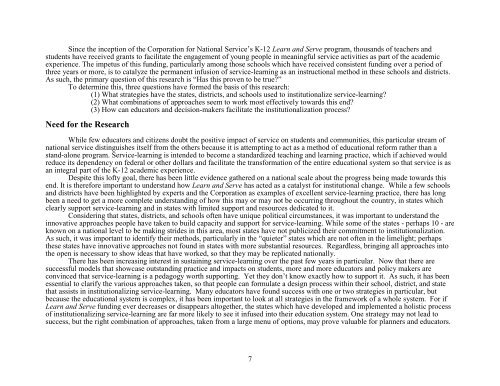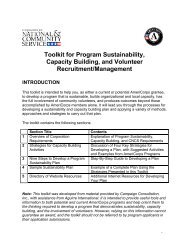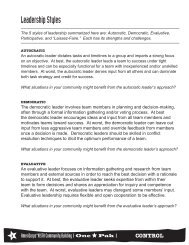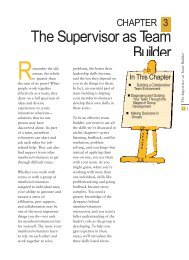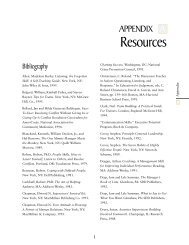MAKE IT LAST FOREVER: THE ... - National Service Resource Center
MAKE IT LAST FOREVER: THE ... - National Service Resource Center
MAKE IT LAST FOREVER: THE ... - National Service Resource Center
Create successful ePaper yourself
Turn your PDF publications into a flip-book with our unique Google optimized e-Paper software.
Since the inception of the Corporation for <strong>National</strong> <strong>Service</strong>’s K-12 Learn and Serve program, thousands of teachers and<br />
students have received grants to facilitate the engagement of young people in meaningful service activities as part of the academic<br />
experience. The impetus of this funding, particularly among those schools which have received consistent funding over a period of<br />
three years or more, is to catalyze the permanent infusion of service-learning as an instructional method in these schools and districts.<br />
As such, the primary question of this research is “Has this proven to be true?”<br />
To determine this, three questions have formed the basis of this research:<br />
(1) What strategies have the states, districts, and schools used to institutionalize service-learning?<br />
(2) What combinations of approaches seem to work most effectively towards this end?<br />
(3) How can educators and decision-makers facilitate the institutionalization process?<br />
Need for the Research<br />
While few educators and citizens doubt the positive impact of service on students and communities, this particular stream of<br />
national service distinguishes itself from the others because it is attempting to act as a method of educational reform rather than a<br />
stand-alone program. <strong>Service</strong>-learning is intended to become a standardized teaching and learning practice, which if achieved would<br />
reduce its dependency on federal or other dollars and facilitate the transformation of the entire educational system so that service is as<br />
an integral part of the K-12 academic experience.<br />
Despite this lofty goal, there has been little evidence gathered on a national scale about the progress being made towards this<br />
end. It is therefore important to understand how Learn and Serve has acted as a catalyst for institutional change. While a few schools<br />
and districts have been highlighted by experts and the Corporation as examples of excellent service-learning practice, there has long<br />
been a need to get a more complete understanding of how this may or may not be occurring throughout the country, in states which<br />
clearly support service-learning and in states with limited support and resources dedicated to it.<br />
Considering that states, districts, and schools often have unique political circumstances, it was important to understand the<br />
innovative approaches people have taken to build capacity and support for service-learning. While some of the states - perhaps 10 - are<br />
known on a national level to be making strides in this area, most states have not publicized their commitment to institutionalization.<br />
As such, it was important to identify their methods, particularly in the “quieter” states which are not often in the limelight; perhaps<br />
these states have innovative approaches not found in states with more substantial resources. Regardless, bringing all approaches into<br />
the open is necessary to show ideas that have worked, so that they may be replicated nationally.<br />
There has been increasing interest in sustaining service-learning over the past few years in particular. Now that there are<br />
successful models that showcase outstanding practice and impacts on students, more and more educators and policy makers are<br />
convinced that service-learning is a pedagogy worth supporting. Yet they don’t know exactly how to support it. As such, it has been<br />
essential to clarify the various approaches taken, so that people can formulate a design process within their school, district, and state<br />
that assists in institutionalizing service-learning. Many educators have found success with one or two strategies in particular, but<br />
because the educational system is complex, it has been important to look at all strategies in the framework of a whole system. For if<br />
Learn and Serve funding ever decreases or disappears altogether, the states which have developed and implemented a holistic process<br />
of institutionalizing service-learning are far more likely to see it infused into their education system. One strategy may not lead to<br />
success, but the right combination of approaches, taken from a large menu of options, may prove valuable for planners and educators.<br />
7


